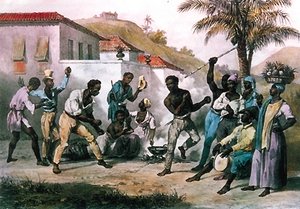|
A Brief History of CapoeiraThe history of capoeira is a complex and fascinating story of the development of a martial art by slaves as a form of self defense. The history provided here is an overview of the major points. It's not complete and thorough, but gives a basic foundation for capoeira's development. Capoeira Origins
This set the stage for the development of capoeira. This part of capoeira history is well known, but the actual creation of capoeira is a lot less clear. There are many theories on how it began, but I'll mention some of the major ones.
There are many other theories, but today, it's extremely difficult to concretely know which is right. What is known is what happened to the history of capoeira after slavery ended... Illegal Times of CapoeiraIn 1888, slavery was abolished in Brazil. This resulted in numerous poor slaves moving to the slums in the cities. Those that knew capoeira began to form criminal gangs. Others became political bodyguards and assisted politicians in terrorizing others with capoeira. This became a threat to to government which responded by creating a special police force against capoeira and eventually made it illegal to practice. The common punishment for practicing capoeira was jail or cutting the tendons on the players legs (ouch!). During this time, capoeira continued in secret. In an effort to avoid being caught, capoeira players adopted the tradition of nicknames, to hide their real identity. Also warnings were created to alert capoeiristas of police, such as the berimbau toque called calvalaria. It was played whenever police were around to inform the players to dance samba instead of capoeira. Capoeira Legitimized
At that time capoeira still had the stigma of being From this point, capoeira began to grow into its modern roots and flourish within Brazil and worldwide. The history of capoeira is amazingly interesting. This overview only provides a brief look at this history but shows the important elements of its past. Now when playing, you'll have a better understanding for the history and traditions that make capoeira what it is today! Return from History of Capoeira to What is Capoeira?
|



 In the 1500s, the Portuguese in Brazil began to import slaves from Africa as a workforce for their sugarcane and other plantations. Over time slaves in various plantations escaped or started small rebellions to get freedom. These escaped slaves began to gather and form quilombos, or communities of escaped slaves, native Indians and other oppressed groups.
In the 1500s, the Portuguese in Brazil began to import slaves from Africa as a workforce for their sugarcane and other plantations. Over time slaves in various plantations escaped or started small rebellions to get freedom. These escaped slaves began to gather and form quilombos, or communities of escaped slaves, native Indians and other oppressed groups. The outlawing of capoeira changed when Mestre Bimba came onto the scene. He reorganized capoeira into his regional style and had performances for both the governor of Baiha and the President of Brazil. This resulted in Mestre Bimba opening the first legal capoeira school in 1937.
The outlawing of capoeira changed when Mestre Bimba came onto the scene. He reorganized capoeira into his regional style and had performances for both the governor of Baiha and the President of Brazil. This resulted in Mestre Bimba opening the first legal capoeira school in 1937.